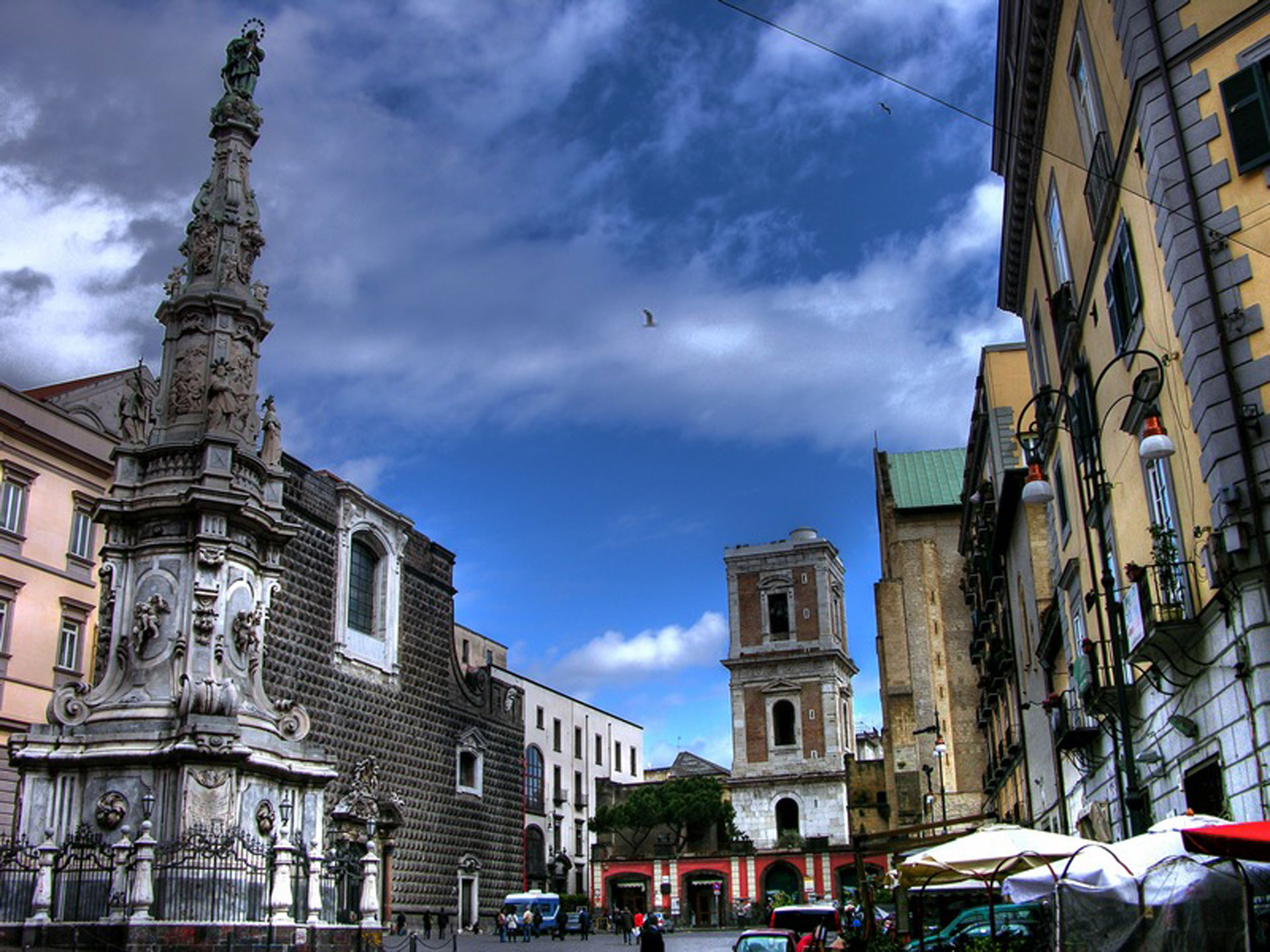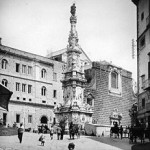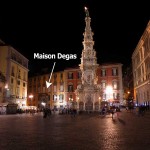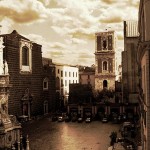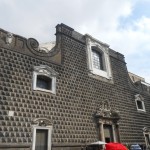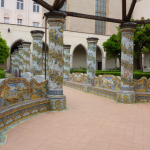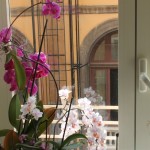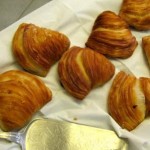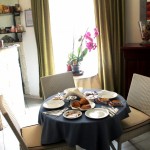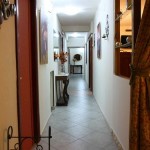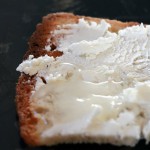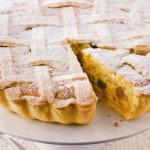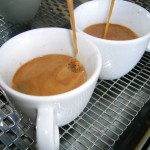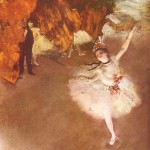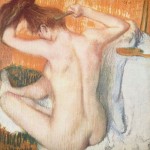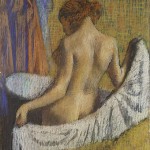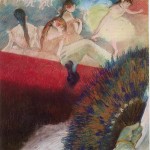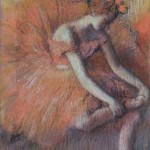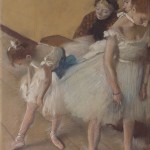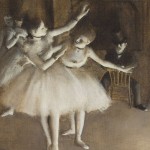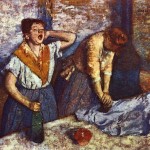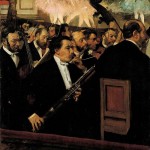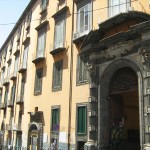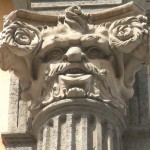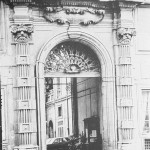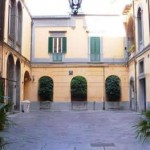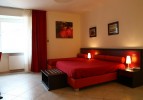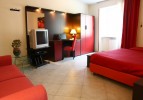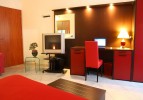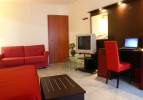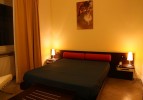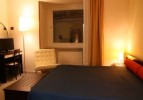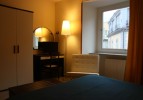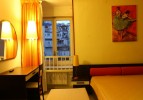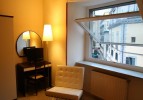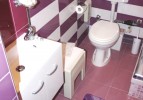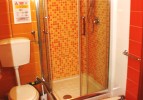
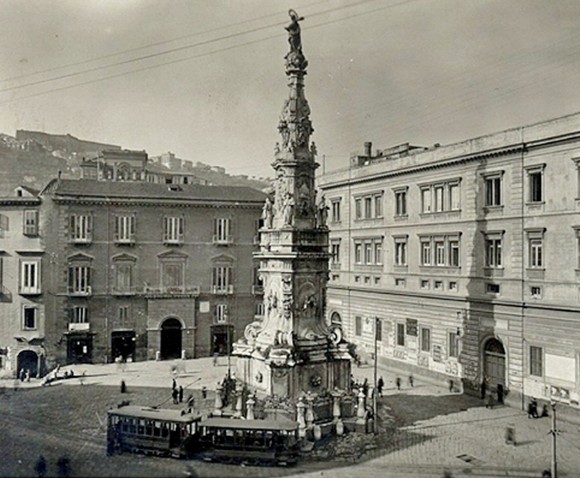
Central location, personal attention, re-enactment of the special atmosphere of the old town between sediments and traces of past eras.
Once upon a time, long time ago…
Austere monasteries, churches enriched thanks to the Baroque, horses’ pawing of the ground, gleaming carriages during the celebrations at the princely stone palaces and . … a flood of craft arts: glass, copper, ceramics, shepherds, mandolins and musical instruments , tailors: the workers of Naples. Nowadays, at the No. 53 in Calata Trinita Maggiore, Piazza del Gesù Nuovo, between the chiseled stone at Palazzo Pignatelli di Monteleone and the slight bustle in the road, you will discover our small and cozy hotel..
Maison Degas, in Piazza del Gesù Nuovo, is the ideal starting point for a cultural and emotional trip. Here you will discover that 3000 years of history –and more – talk to you through the stone, modeled by exquisite architectures, through the vivacity and curiosity of the local people, and murmur in the narrow alleys, that are the perfect location for fortuitous encounters.All this will exercises a unique fascination over our guests, enchanted by the whispering charm of the tiny streets and the vastness of our artistic heritage.
The welcome at Maison Degas… an encounter, an exchange between different sensitivities, an opportunity to know each other by sharing a good cup of coffee or by tasting our typical pastry.
The traveler who chooses us is, above all, a customer who deserves attention.
Our hotel boasts a very central and strategic location
Piazza del Gesù Nuovo, where Spaccanapoli starts, gives direct access to the historic center of the city, UNESCO World Heritage. Placed Among the severity of the gothic style, the fineries of Complesso Monumentale di S. Chiara the reassuring gaze of our Lady’s statue, overlying the obelisk in the middle of the square, and the majesty of the Baroque architecture, Maison Degas is located inside the XVI century Palazzo Pignatelli di Monteleone, today a national monument. The inscription placed on the right side of the entrance by the French institute Grenoble of Naples reminds us that, in the XIX century, the French impressionist painter HILAIRE GERMAN EDGAR DEGAS (1834-1917) lived here with his family.
reminds us that, in the XIX century, the French impressionist painter HILAIRE GERMAN EDGAR DEGAS (1834-1917) lived here with his family.
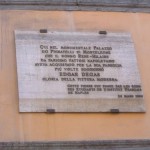 THE OLD TOWN CENTER OF NAPLES was declared UNESCO WORLD’S HUMAN PATRIMONY in 1995, because Naples is one of the most ancient city in Europe, whose contemporary urban pattern preserves the elements of its long and important history.
THE OLD TOWN CENTER OF NAPLES was declared UNESCO WORLD’S HUMAN PATRIMONY in 1995, because Naples is one of the most ancient city in Europe, whose contemporary urban pattern preserves the elements of its long and important history.
The centrality of the position will reveal to the hotel’s guests the tradition, the cultural events, the historic and artistic preciousness of Naples back in the day, the shopping streets. For those who travel for pleasure, for culture, for relax, for those who stay for business and are looking for a quiet location in the heart of the inner city, in a strategic position.
In Naples through unforgettable pizzas and historical monuments: from Spaccanapoli to Piazza del Plebiscito, passing through Chiaia district and the famous Santa Chiara monastery. You can see Spaccanapoli, straight like drawn with a ruler,the most famous Neapolitan street, congested city heart and street of merchandise…
Corriere della Sera, 05 settembre 2013
In Naples like being at home
We want our guests to perceive the warm house atmosphere, suggesting them the cultural events that Naples can offer (events, conventions, live music, show), with a particular attention to the important handcrafted tradition of Naples, capital of the Two Sicily Kingdom, the artistic contemporaneity and the typicalness of the “wine and food” Neapolitan and Campania tradition. And then… in the morning an encounter, a convivial atmosphere, a “Chiacchiera” (a chat) to discover the tradition of the Neapolitan pastry with a testing of every kind of speciality… with a nice soft music, classic or jazz.
Services
- private bathroom with shower and hair dryer
- plasma screen tv
- telephone
- wireless internet connection
- central heating
- air conditioning
- safety box
- additional bed or cradle (on request)
- Ticket office service for concerts, shows, theatre, sport events
- Breakfast from 8 a.m. to 11 a.m.
- Front office assistance from 8,30 a.m. to 11 p.m.
- luggage transport (on request)
- fast laundry service (on request)
- bar room service
- free luggage storage
- tourist informations and maps
- parking garages with agreed prices
- Night service with an on-call available responsible
- guided tours and excursions booking service
Extra services
- Tranfer to/from the airport – central station – port with agreed prices
- shuttle service for small groups (min. 8)
- travel and tourism agency services
- ferry and train Ticket office
- Thematic guided tours
- Ticket service for Concerts, Theatre, Shows
- car rental booking service, with or without driver
- bike rental
- gym and wellness center agreed prices
- fax and copy service


The historical house of Edgar Degas
During the first twenty years of his career, Degas experimented every genre. He immediately had a predilection for the portraits. In those paintings, the extra elements sometimes become so important that the works looks like half-portraits and half still-life. He was able to create great paintings such as La famille Bellelli.
.At the beginnings of 1860, Degas faces the genre of historical painting, using in a very personal way, different inspiration sources. In that moment, he doesn’t drop out from the genre painting, getting soon into horse races, ballet, theopera, the caffè-concerto, and the daily life.
The ballet was a subject that will mark Degas career indelibly. He was enchanted by those dancers lighting the scene. They were, for him, like stars none could stop to look at. He used to paint them while they got ready, in the backstage and during their exhibitions. Degas used to go on place to represent in a better way every little detail.. You can find in each room Degas’ dancers paintings; they are our little gift to the artist and his many secrets…
Degas' Dancers
From “Degas – Ballerine”, Arnoldo Mondadori Editore, Collana “La Tavolozza”, 1956 […] The movement, here is the favorite theme of that sedentary man who says that to work profitably you must “get on board”. Prisoner of a laboratory where he recreates the reality, the one who, according to Valèry, “couldn’t see anything in pink”, showed with pain the delicious and fleeting moment and changed the silent canvas in a field of action, the place of the duration and depth.
Dance classes, all the preparatory exercises, the tests in the foyer or on the scene, the life of the stage, the backstage, the trivial gestures and the professional gestures, excite his curiosity as the representation from the theatre and the unreality atmosphere on the stage, thanks to the costumes, the scenery, the reflectors and ballets.
How many mornings, how many afternoons spent in via Le Pelletier or the Opera foyer, to observe the “small class” train to the bar, to the orders of the old master of the ballet in smock. Hundreds of drawings, engravings, paintings, pastels, monotypes to testify to the passion with which Degas studied these dance scenes that he later revived one by one on the canvas, transforming the fleeting impressions in durable performances of grace.
From pastel, which is both graphic and color, expressive means faster, vigorous and alive oil, Degas drew the most unusual effects. It seems that no one before him has been able to exploit so skillfully “tones dead” to exalt, thanks to the contrast, warm tones and make isolated figures (such as the Star of the collection Camondo) or group (the Three, the Four ballerinas ), caught in action or at rest, the most beautiful bouquets.
Degas in Naples
I viaggi a Napoli nel periodo giovanile
Son of the noble family’s banker Auguste DE GAS and Celestine Musson, related with the Barons Belelli of Naples, Edgar Degas often traveled between 1856 and 1860 in Italy, initially in Naples, where his family resided, then to Rome and Flowrence.
Palazzo Piagnatelli of Monteleone is the wonderful frame where the young painter lived during his stay in Naples, together with his grandfather Hilaire who loved him a lot. In the Palace still today lives the last Degas’ descendant.
Naples, doubtless, has left an indelible sign in the formation of the painter, both from the artistic point of view and in the development of his personality. The reform of arts in Naples was very interesting for Degas, his mind is receptive and sensitive to new things. In the Neapolitan artistic environment he can maneuvers magnificently. He is interested in the art of Filippo Palizzi. It is known that Degas had direct and frequent contacts with Neapolitan painting, in 1854 he was in Naples , probably he was here for a long time, and he had contact with the Real Institute of Belle Arti.
Degas was often at the Borboni museum, where he does several copy from the ancient paintings. He was in Ercolano, Pompei, where he studied the mosaics and the paintings. He had predilection for Naples underground, he visited S. Gennaro’s catacombs, he copied their wall paintings, authentic examples of early Christian art. He had interest for the interior of the churches, he copied a Donatello in the chapel Brancacci of S. Angelo a Nilo and continued through his cultural itinerary.
The young Degas left the juridical studies to dedicate himself completely to the art. The father, August Degas, born in Naples and banker in Paris, fully understood the passion of his son and encouraged him. The same did his grandfather, Hilaire Degas. The grandfather Hilaire was the ancestor of the Neapolitan family of the artist, he escaped from Terrorese in 1794, and he took refuge in Naples, becoming a banker and he married a Neapolitan woman.
Despite the extended French historiographical production and critic that try to give a misrepresenting image of the Degas work through a strong nationalistic attitude, Naples can be considered as the starting point of Degas art. Degas always expressed himself in Neapolitan dialect, leaving his French contemporaries bewildered. The root of his art is different, more far away from the Parisian cultural field.
Degas was enchanted by Naples; he had a durable admiration for its his art and its culture. Degas had clear, crystalline, the idea of curiosity, the observation of things, animals, human been, the sense of order and harmony, the movement. They are the result of a curious spirit, never fully-happy of what he had, but always searching for something new: Thanks to his “style” and “poetic”, his being deeply and empathetically close to the spirit and ways of conceiving life, Degas can be considered closer to the Mediterranean nature of Neapolitans, to the southern Italian world.
Tratto dal libro “Rosa Spinillo, Degas e Napoli – gli anni giovanili, Plectica, Salerno 2004”
FOCUS: Il Palazzo Pignatelli di Monteleone
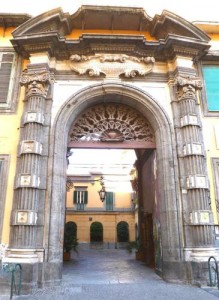 The building, which is now a National Monument, was erected in the sixteenth century by the Duchess Giroloma Column and occupied the entire insula between Calata Trinita Maggiore, Via Domenico Capitelli, street and alley Maddaloni Monteleone, and here placed on the border with the ownership of the vast ddel Marquis with a host of smaller buildings. Originally the building also housed the paintings by Paolo De Matteis depicting some episodes of the Aeneid and the Gerusalemme Liberata. In 1718 the Duke Nicholas commissioned the architect Ferdinando Sanfelice the renovation of the central part of the building. the Sanfelice, among other things, invented what remains one of the portals of the most interesting and grandiose Baroque era.
The building, which is now a National Monument, was erected in the sixteenth century by the Duchess Giroloma Column and occupied the entire insula between Calata Trinita Maggiore, Via Domenico Capitelli, street and alley Maddaloni Monteleone, and here placed on the border with the ownership of the vast ddel Marquis with a host of smaller buildings. Originally the building also housed the paintings by Paolo De Matteis depicting some episodes of the Aeneid and the Gerusalemme Liberata. In 1718 the Duke Nicholas commissioned the architect Ferdinando Sanfelice the renovation of the central part of the building. the Sanfelice, among other things, invented what remains one of the portals of the most interesting and grandiose Baroque era.
The interior: After the first flight of the beautiful, bright and impressive stairs piperno, the visitor sees an antechamber space, with a delicious lineup of white marble, contained between mild and fluted scrolls, made for the invitation to the next room d ‘ waiting. Here and there ‘a wooden staircase with two flights elittichw opposing sinuously harmonized with the gallery through two balconies in the round, among which is a bench resting on the seabed of wooden panels, lining the side walls. The notary G. De Vivo, we learn that in 1723 of paintings, large and small, there were more ‘than a thousand, and all of famous authors: CARRACCI, GUERCINO, BRUEGEL, TINTORETTO, RUBENS, Vaccaro, Giordano, Solimena … COULD NOT THEN MISS A NICE AUTHOR NATIVITY.
(G.MACCHIAVELLI- F.TIRONE I TESORI DI PIAZZA DEL GESU’ NUOVO pp. 17-18)
The palace is located in front of the other, Prince formwork, General Francis Statella, then also purchased largely by others, near the large square of Jesus again, in which, in place where it was was erected in 1703 a monument to Philip V then shot down by followers of Charles VI in 1707, was built – and still is found – the spire bearing the statue of the Immaculate. In the construction of the majestic portal alternate, decoratively finished, the dark piperno, feature stone Neapolitan derived from consolidated lava eruptions of Vesuvius, and friezes of white marble: the wide courtyard, spacious and comfortable the whole piperno main staircase, spacious rooms and bright.
The palace was remembered by Giacomo Casanova in his “Memoirs” for lavish receptions, lunches and dinners nightly based “macaroni and seafood, and especially for the long nights, which, with great discretion, there is spent, in one of its many rooms on the third floor, at the table, by the owner of Duke Pignatelli Monte Leone, from Carafa Duke of Maddaloni, by Statella prince of the formwork and other Neapolitan aristocrats.It was only in 1832, by deed dated June 1, for notary Casale di Napoli, the Prince Don Diego Pignatelli, Duke of Monteleone, and his other relatives, dispossessed him, he was able to receive the cumbersome procedures of all time, the balance of the price, with obvious benefit of the purchaser Degas.
The Palazzo Pignatelli di Monteleone became the palace of the banker Degas and he moved there with his wife and numerous offspring, in 1825, entrusting the restoration and adaptation to the needs of his home to another famous architect of the time, Stefano Gasse , also of French origin.
(a c Tratto da “Degas e la sua famiglia in Napoli” 1793 – 1917 di Riccardo Ramondi, SAV Napoli)
FOCUS: Palazzo “del Gas”
Not everybody knows that the great painter Edgard Degas had Neapolitan paternal grandparents and father. Who were the Degas? A family hailing from France, from the region of Langue d’Oc from the surname De Gas, De Gast, De Guast and after the French Revolution in the current form of Degas, nobles and lords with the predicate “De Bagnolis” from the XIII century, to which they added the current surname in the XVI century, registered at the nobility and at the “Gentlemen Catalogue” of the Langue d’Oc province from the November 8th 1670, with the registered escutcheon in the “General Armorial” year 1969 and in the “Registre de la Generalitè de Montpelier” at the page 537, knights of the prestigious order of Orleans, royals of France.
Brigantino – Il Portale del Sud
Our Bedrooms
Hotel Maison Degas provides to the guests a cozy hall with coffee bar, TV and music. We have 7 rooms: 1 superior (triple/quadruple, perfect for families), 3 double rooms (also available as DUS) and 3 double standard.
Rooms are in modern style and with all comfort and functionality requirements.
From here, your look is captured by the magic of the natural light, playing an impressionistic game on the buildings of the square…

BOOKING ONLINE
Triple/quadruple room from 90€
Room n.2 “Dancers in rose”: cozy 30 mq room with private bathroom; 1 double bed, 1 single bed, 1 double sofa bed or 1 extra single bed; desk, table, bed side cabinet, wardrobe, fridge, luggage rack. This room faces overlooks the wonderful Piazza del Gesù
Double or twin room from 75 euros (60 euros for single use)
With view, on request, on the square or facing the court yard of the sixteenth century Palazzo. Cozy 15 mq rooms, with 1 double bed or 2 twin beds, extra single bed on request; desk, bed side cabinet, waedrobe, luggage rack.
Free services for our clients at the arrival
- 1 bottle of mineral water
- Welcome drink
- Upgrade to a higher room category (subject to availability)
- City maps and tourist information
- Reception in English
- Reception assured 16/24
- Ticket entrance fee for the monumental complex of St. Clare
Amenities
- private bathroom with shower and hair dryer
- plasma screen tv
- telephone
- wireless internet connection
- central heating
- air conditioning
- safety box
- additional bed or cradle (on request)
- Ticket office service for concerts, shows, theatre, sport events
- Breakfast from 8 a.m. to 11 a.m.
- Front office assistance from 8,30 a.m. to 11 p.m.
- luggage transport (on request)
- fast laundry service (on request)
- bar room service
- free luggage storage
- tourist informations and maps
- parking garages with agreed prices
- Night service with an on-call available responsible
- guided tours and excursions booking service
Extra services
- Tranfer to/from the airport – central station – port with agreed prices
- shuttle service for small groups (min. 8)
- travel and tourism agency services
- ferry and train Ticket office
- Thematic guided tours
- Ticket service for Concerts, Theatre, Shows
- car rental booking service, with or without driver
- bike rental
- gym and wellness center agreed prices
- fax and copy service
Check-in and Check-out
Check-in time from midday to 8 p.m.
Check-out time before 11 am
Late check-out:on request, based on availability. Waiting for the access in the room or before leaving, you can leave your luggages at the front desk with no extra costs.
Cancellation Policy
If the arrival date is cancelled or modified up to 2 days before, no fee will be charged. Later or in case of no-show, 100 percent of the first night will be charged.

Prezzi per camera |
Bassa Stagione |
Media Stagione |
Alta Stagione |
|---|---|---|---|
DAL 10/01 AL 29/02DAL 05/11 AL 30/11 |
DAL 01/03 AL 31/03DAL 01/08 AL 31/08 |
DAL 01/04 AL 31/07DAL 01/09 AL 04/11DAL 06/12 AL 09/01 |
|
Doppia uso singola |
60,00 € |
65,00 € |
70,00 € |
Doppia uso matrimoniale |
80,00 € |
85,00 € |
90,00 € |
Tripla / Quadrupla |
100,00 € |
110,00 € |
120,00 € |
Letto aggiunto |
10,00 € |
10,00 € |
10,00 € |
Bambini 0-12 anni in camera |
Gratis |
Gratis |
Gratis |
*The above-mentioned rates are per room, per night, with continental breakfast (Vat 10% included). Children under 12 extra bed free. Small size Pets are allowed (on request). ** Rates do not include city tax (2 euros per person per night) :according to the authorities of the city.The tax is not applied to children under 18 years old and local people

